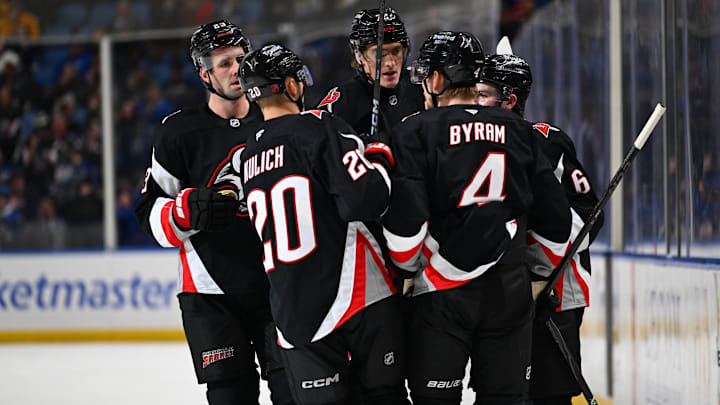A few shreds of optimism have emerged within the Buffalo Sabres fanbase amid the team's 4-4-2 start to the 2025-26 season. The record is modest but the product on the ice is an obvious improvement compared to what fans have witnessed over the past two years.
Not everybody is buying the renewed hope, though. Justin Bourne of Sportsnet still doesn't see a playoff-caliber team in Buffalo.
"Josh Norris' injury obviously hurts, though some might call that self-inflicted since the Sabres traded for a player with such an injury history," Bourne wrote. "In all, there's just not enough here to call them a playoff threat. They need a bigger, more direction-changing move."
He added: "The Sabres are not a punchline this year. Unfortunately, it's tough to have faith in them making the right moves to climb into playoff contention, but they're not that far off."
For most rebuilding teams, making clear strides toward competitiveness is a welcome sign of progress. That's not the case for Buffalo because of its 14-year playoff drought. Simply getting a little better isn't enough to fully reignite a hockey-crazy market.
What do the underlying metrics say about this season's Buffalo Sabres?
Although the eye test suggests the Sabres are a tougher team to play against, in large part because of hardworking players like Josh Doan, Zach Benson and Tyson Kozak (who's currently injured), the stat-based analytics view doesn't necessarily agree.
Here's a look at where Buffalo ranks in some key categories in the game's three phases, via Natural Stat Trick:
Even Strength
- Goals for percentage (GF%): 42.9 (27th)
- Expected goals for percentage (xGF%): 46.4 (26th)
- High-danger chance for percentage (HDCF%): 46.8 (21st)
Power Play
- Expected goals for per 60 minutes (xGF/60): 8.54 (20th)
- High-danger chances per 60 minutes (HDCF/60): 22.36 (21st)
Penalty Kill
- Expected goals against per 60 minutes (xGA/60): 9.35 (20th)
- High-danger chances against per 60 minutes (HDCA/60): 27.98 (21st)
So, how does a team with those lackluster underlying numbers sport a .500 points percentage through 10 games? Goaltending.
Alex Lyon, who's started eight of the Sabres' first 10 contests, has stopped 6.57 goals above average, which ranks fourth in the NHL, per NST. His .919 save percentage rates eighth in the league among goalies who've played at least 200 minutes so far.
Lyon has essentially single-handedly ensured Buffalo didn't start the season in a massive hole. His career track record (.903 SV%) suggests he won't play at this level all year, though.
So, it's up to his teammates to take their games to another level if the Blue and Gold are going to make a serious postseason push in the coming months.
Namely, Rasmus Dahlin needs to elevate his level of play. He entered the campaign as an expected Norris Trophy candidate and he hasn't performed anywhere near that standard. (There are off-ice personal matters that must be considered.)
Along with Dahlin, other core players like Tage Thompson, Alex Tuch, Owen Power and Bowen Byram also haven't produced up to their full potential in the season's early stages.
Eventually, and probably sooner than later, the reason for the Sabres' success (or lack thereof) will have to shift from Lyon to those franchise pillars. If they don't start playing better on a game-to-game basis, the results are likely to turn against Buffalo.
Yes, the Sabres are playing a better brand of hockey. There's no doubt about that. It's nice to see players attacking the net aggressively and scoring some grind-it-out goals or after some nice passing plays rather than everything having to come off the rush or an individual effort.
The work is far from done if Buffalo wants to keep pace in the Eastern Conference, though.
